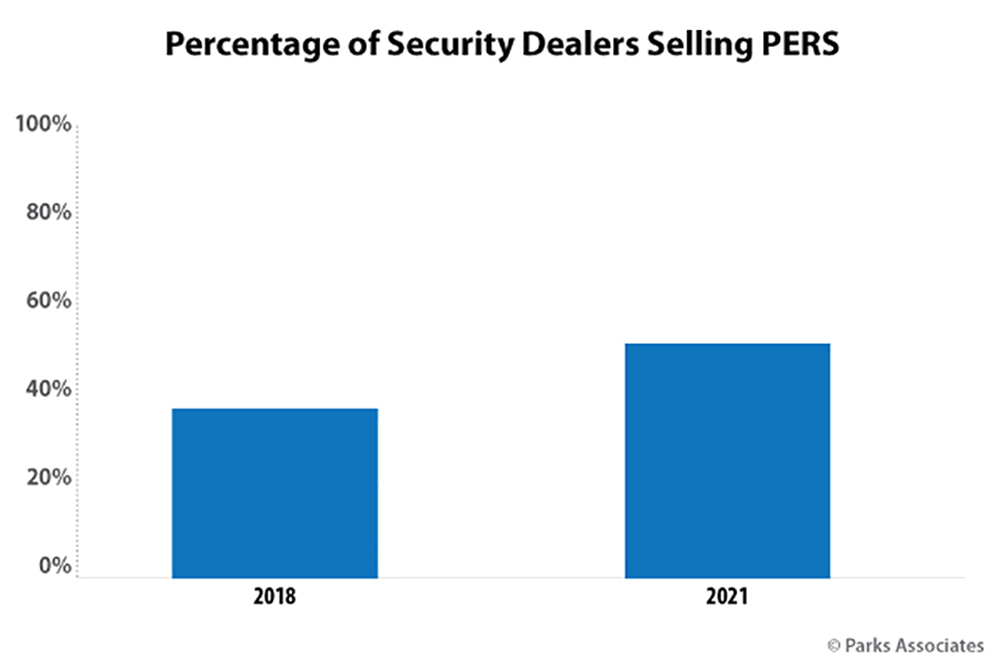The development of smart sensors and the decreasing costs of devices have made it possible to offer aging-in-place, chronic disease management, and post-acute care services in the smart home. Sensor-based technology continues to enable new applications related to health and wellness, with senior solutions and sleep tech leading the way.
Senior tech picks up steam, with overlapping interest from the smart home and healthcare industries.
The pandemic has spotlighted the vulnerability of older consumers and the need for thoughtfully designed technologies and services to reach them at home. A growing number of home security providers are branching out into offering Personal Emergency Response Systems (PERS) to their customer bases, and PERS solutions providers are likewise building out new remote patient monitoring platforms. With a growing focus on care in the home, expect PERS providers to serve as the bridge between medical providers and the home services industry.
PERS solutions lead the independent living solutions market, with 58% of family caregivers reporting that they intend to purchase for their loved ones.

Additionally, as more and more healthcare activities take place from home, continuous monitoring solutions — including those that can track a patient’s status overnight — and new technology like artificial intelligence will be critical to support communications between providers and patients. Solutions that offer continuous and passive monitoring will play a critical role in helping to fill the gaps, particularly in assessing patient deterioration or important changes in health conditions.
As of 2021, almost a quarter of heads of US broadband households report either currently caring for a loved one or expecting to provide care in the next five years. A majority of the cared-for population resides in their own home or a relative’s home. Parks Associates research reports that consumers have a strong desire to live independently, and sensor-based technology will enable seniors and caregivers to have relevant notifications that are meaningful.
Addressing the Overnight Insights Gap: Sleep as a Vital Sign
A patient’s sleep patterns, and overall health status overnight, remain as blind spots in many remote patient monitoring programs. Interestingly, studies show that patients get particularly poor sleep in a hospital setting, given the frequent disruptions for nighttime vital sign monitoring. Part of the push to at-home recovery and care are the benefits patients receive from sleeping more comfortably. Still, this means a potential risk of missing patient deterioration, without the right monitoring tools.
Additionally, there is growing recognition among healthcare providers and clinical researchers that sleep duration and quality is so fundamental to overall patient health, and potentially indicative of a variety of serious health conditions, that it should be treated as a core vital sign. Poor sleeping habits can both cause and exacerbate a number of other health conditions as well, including congestive heart failure, COPD, asthma, heart disease, and obesity. Overnight monitoring provides clinicians with increased insight and detail into the data related to vital signs. According to leading medical reports, the most critical health events are preceded by warning signs that are detectable hours prior to the event.
The ability to provide insight from vital sign data during sleep enables a more comprehensive view of chronic and high-risk conditions. Continuous overnight monitoring delivers clinicians’ increased temporal insight and ability to pair data related to sleep quality with vital signs for a more comprehensive look at key clinical markers common in chronic and high-risk conditions. According to the American Academy of Sleep Medicine, “current data supports the importance of healthy sleep for cognitive and mood function, as well as cardiovascular, cerebrovascular and metabolic health. Chronic insufficient sleep was found to be associated with increased morbidity and mortality.”

Consumers are showing a growing awareness of the importance of sleep. Ten percent of US broadband households report owning a smart sleep product, such as smart mattresses and stand-alone sleep monitors. This is double the adoption rate from just two years prior. Consumers also show interest in features of smart products that can monitor or optimize their sleep as the firm’s research reveals that one in five seniors find a smart thermostat that detects their sleep patterns and optimizes their home’s temperatures to ensure their best sleep “very appealing”. This is even higher among pre-seniors: 31% of those ages 50-59 are interested in this capability. Also, over half of those intending to purchase a smartwatch in the next 6 months say they would pay more for a model that can track their sleep quality and patterns and give advice on how to improve their sleep.
For more information on digital health, new business models, IoT technologies, consumer behaviors, and deployments relevant to consumer healthcare solutions, please visit www.parksassociates.com or attend one of its 2022 Connected Health Summit sessions.
This is an excerpt from research in cooperation with EarlySense.















